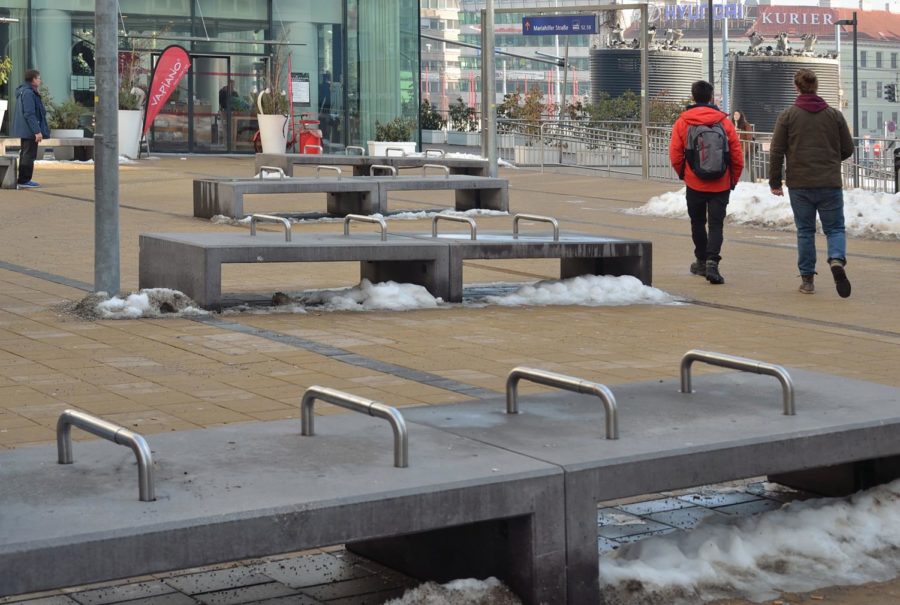Editorial: Stop hostile architecture
Christian Philipp
Hostile architecture can look like a lot of things, one of the most common examples is the addition of armrests on benches.
October 7, 2020
Every city, every town and every community has individuals who are either facing homelessness or are currently homeless. Some of those communities seek to help those who are homeless by offering shelters and food or phone cards and other resources, but on the other end, some communities seek to drive these individuals from the public eye and away from their own.
And they do this through a system of hostile architecture.
Hostile architecture is defined as “the design of buildings or public spaces… which discourages people from touching, climbing or sitting on them, with the intention of avoiding damage or use for a different purpose,” according to Macmillan Dictionary.
That’s correct. It is the direct design to discourage public space use, and even though the idea is to prevent “misuse,” it also deters those individuals in the community who are facing homelessness and need to use those public spaces as places to sleep and simply exist.
Hostile architecture can consist of slanted benches at bus stops, small fences in business alcoves or spikes cemented in chunks of sidewalk that seem random until you notice the spot in question is protected from rain or the blistering sun. It may not be prevalent in small towns, but it is starting to pop up all over big cities.
One of the most common examples of hostile architecture is armrests in the middle of benches. While on the surface these armrests seem innocuous, they’re again a feature that’s been designed to stop people from sleeping on benches.
These benches have even been found in Iowa. The Daily Iowan reported benches appearing in August as a form of hostile architecture.
These “design features” aren’t pretty and are doing nothing but displacing an already displaced community, which consists from veterans and LGBTQIA+ youth to those with mental illness and young parents.
Seventeen out of every 10,000 people in the United States experienced homelessness at least one night in January 2019 during HUD’s Annual Point-in-Time Count. These 567,715 people represent a cross section of America. They are associated with every region of the country, family status, gender category and racial/ethnic group.
For Iowa specifically, as of January 2019, Iowa had an estimated 2,315 individuals experiencing homelessness on any given day, as reported by Continuums of Care to the U.S. Department of Housing and Urban Development (HUD).
Of that total, 227 were family households, 149 were veterans, 146 were unaccompanied young adults (aged 18-24) and 340 were individuals experiencing chronic homelessness.
Homelessness is also in Ames, which is often seen as an affluent community because of Iowa State University and its number of wealthy, suburban neighborhoods. However, the Ames Tribune reported there were over 100 homeless students attending Ames High School in 2018.
The United States definitely has a homeless problem and there are many things we need to do about it, and the crime within that community is part of it. The argument for hostile architecture is it can deter crime or keep unwanted people out of the area and that does seem like a worthwhile idea.
From a search of 21 studies, 15 examined the prevalence of contacts of homeless individuals within the criminal justice system: lifetime arrest rates ranged between 62.9 percent and 90 percent, lifetime conviction rates ranged between 28.1 percent and 80 percent and lifetime incarceration rates ranged between 48 percent and 67 percent. Four studies examined self-reported criminal behavior, with 12-month rates ranging from 17 percent to 32 percent.
So it does seem a lot of the homeless population has had some sort of run-in with law enforcement, but is putting up ugly metal bars and spikes really the right idea? No, it isn’t.
Cities will spend thousands of dollars on building hostile architecture as a reaction to a problem. They aren’t solving anything. In fact, they are making things worse for people all over the country. Let us instead spend that money elsewhere.
How about dedicating it toward building more homeless shelters or renovating the ones already in operation? Dedicate that money toward clothing and food and phone cards for those facing homelessness. Dedicate that money toward job training and resume workshops. Dedicate that money to fixing the problem, not reacting to it.
Every person all across the world deserves a place to sleep. Let us give enough respect to those who live in our country, those who served our country and give them a place to sleep, or at the very least allow them to find somewhere to sleep easier.

















